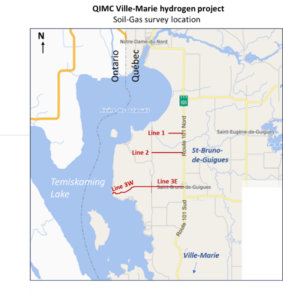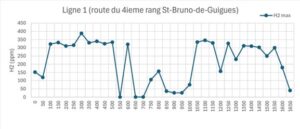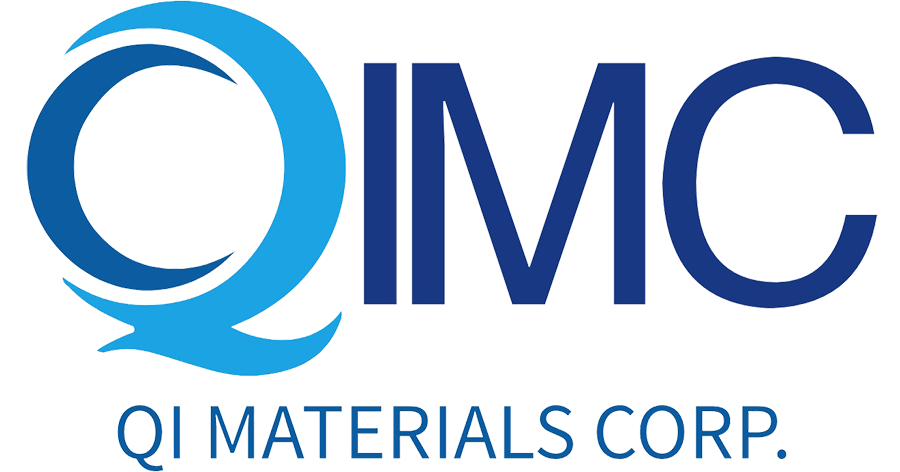Lachute, Quebec, July 25, 2024–- Quebec Innovative Materials Corp. (CSE: QIMC, FSE: 7FJ) (“QI Materials”, “QIMC” or the “Company”), proudly announces the identification of significant natural hydrogen anomalies across its Ville Marie project Quebec. This milestone discovery stems from the initial results of the highly anticipated soil sample program conducted in collaboration with the Institut National de la Recherche Scientifique (INRS). The highest hydrogen concentrations were observed on the Route du Rang IV in St-Bruno-de-Guigues (Line 1). These show hydrogen concentrations grouped into two strong anomalies observed over a length of 500 m each. The first zone shows hydrogen concentrations ranging from 311 to 388 ppm (parts per million), while those in the second section range from 157 to 346 ppm (Figures 1, 2 and 3).
“This discovery of natural hydrogen anomalies represents a pivotal achievement for QIMC and our partners at INRS,” said John Karagiannidis, President of QIMC. “It underscores our commitment to pioneering sustainable natural hydrogen clean energy development while positioning Quebec at the forefront of clean energy innovation.”
“These findings unequivocally show the presence of very strong hydrogen anomalies at concentrations and in areas never before observed in Quebec,” highlights Professor Marc Richer-Laflèche, scientific head of INRS’ Applies Geoscience Laboratory.
“The results mark a transformative moment in our exploration efforts,” said John Karagiannidis, President of QIMC. “Natural hydrogen, a key element in the global transition to sustainable energy solutions, holds great promise for advancing clean energy initiatives and driving economic growth.”
During the first two weeks of July 2024, the team of the INRS Applied Geosciences Laboratory started a soil-gas survey with a linear spatial resolution of 50 m along 4 sections: line 1, 1.65 km long; line 2, 3.1 km long; line 3, 3.25 km western section; and line 3, 4.3 km eastern section, along the Route du 4ème Rang, the Route des 3ème et 4èmes Rangs, and the Route du Quai in St-Bruno-de-Guigues, respectively (Figure 1). The initial goal of this work was to validate the geological, geophysical, and geochemical models and interpretations of Prof. Richer-LaFlèche, which suggest that the Temiscamingue Graben could be an exceptional geological environment for white hydrogen (dihydrogen) exploration in Quebec.

Figure 1: Location map for lines 1, 2, 3 East and 3 West of the INRS soil-gas geochemical survey conducted in July 2024 on QIMC’s Ville-Marie project. St-Bruno-de-Guigues sector (Témiscamingue RCM). Map modified from SIGEOM (MRNF).

Figure 2: Spatial distribution map of hydrogen anomalies projected on satellite images.

Figure 3: Section of Line 1 at St-Bruno-de-Guigues showing highly anomalous hydrogen zones (soil-gas). Distances (x-axis) are in meters. Section from east to west (source: INRS).
The Route des 3ème et 4ème Rangs section (line 2) also shows the presence of strong hydrogen anomalies (e.g. stations 900m, 1100m and 1200m: 310, 365 and 318 ppm, see Fig. 2). These anomalies are more concentrated (narrow) than in the Route du 4ème Rang section (line 1). Line 3 West, which terminates at the edge of Lake Témiscamingue, shows a 500 m wide intersection (from 2500 to 3000 m) with hydrogen concentrations ranging from 155 to 410 ppm (275 ± 73 ppm, see Fig. 2). This intersection does not appear to be related to the previous ones as it is located much further west.
A new zone of high hydrogen concentrations was observed on July 22, 2024, covering almost 1 km in the eastern part of the Route du Quai de St-Bruno-de-Guigues (Line 3, eastern section). Hydrogen concentrations in this area, between stations 650 and 1650, averaged 260 ± 72 ppm (Fig. 2) (n=21 samples). This section is located 5.3 km south of the Route du 4ème Rang section (Line 1).
Professor Marc Richer-Laflèche comments: “If we compare the hydrogen concentrations observed in the soils of St-Bruno-de-Guigues with those measured in Témiscamingue in the volcano-plutonic belts of the Pontiac (Baby and Belleterre groups) (Fig. 4; INRS 2023 data, the data for the Midrim sector come from the municipality of Laverlochère, while the data for the Aubelle sector (Vior inc.) come from the municiplaity of Belleterre), it clearly underlines the fact that hydrogen concentrations (soil-gas) measured within the Temiscamingue graben are systematically higher than those of volcano-plutonic environments, which those volcano-plutonic environments should theoretically be favorable for hydrogen formation (according to the well know greenstone model).

Figure 4: Compilation of data from Lines 1, 2, 3 East and 3 West of the Ville-Marie Project (QIMC) and soil gas data measured over volcanic (basalt) and intrusive (gabbro) rocks in the Baby and Belleterre Groups, Témiscamingue. The data from the Baby Group (Midrim area) and the Belleterre Group (Aubelle area) are from the FRQNT-MRNF-Mines research project on the soil gas prospecting method for sulphide mineralization. This project is carried out in collaboration with Vior Inc. for the Témiscamingue area (Marc Richer-LaFlèche, INRS and Li-Zhen Cheng, UQAT). The soil gas data for the Midrim and Belleterre sectors are part of Antoine Cuckovic’s PhD thesis in Earth Sciences at INRS (source: INRS and Vior Inc.).
“The spatial distribution of these QIMC’s Ville Marie anomalies a priori suggests a large-scale diffusive hydrogen transfer process, possibly related to the presence of a secondary fault associated with the Temiscaming Graben”, said Professor Marc Richer-Laflèche. “Hydrogen-rich anomaly domains with high continuity (> 500m) tend to cluster in a relatively fine-grained glaciolacustrine sedimentary formation, which could act as a cover for an auxiliary reservoir possibly located in coarser glacial or fluvio-glacial Quaternary sediments. However, field observations indicate that the high hydrogen concentrations detected in soils are not restricted to fine-grained glaciolacustrine sediment facies. For example, several high amplitude hydrogen anomalies are also observed in soils underlain by sandy-gravelly substrates and bedrock (e.g. line 3 west, beginning of line 1)”.
Several sources could be involved in the production of hydrogen in the Temiscaming Graben: 1) the presence of potassic arkosic rocks (rich in uranium and thorium) of the Cobalt Group could contribute to the formation of hydrogen by radiolysis 2) ultramafic rocks and iron formation units of the Baby Group cut by the graben and overlying sedimentary rocks could produce hydrogen. and 3) a third not negligible source could be metasomatized mantle peridotites in the lithospheric mantle beneath the Témiscamingue continental crust. This event could be related to the kimberlitic magmatism that affected the region in the Cretaceous.
“All of the anomalously high hydrogen concentrations mentioned in the release reflect exceptionally high concentrations of hydrogen in the soils of the St-Bruno-de-Guigues area of Témiscamingue”, said John Karagiannids, President of QIMC. “We are adding more personnel and equipment to the area and additional work is planned to detect the presence of hydrogen mineralization at depth.”
Gravity and audiomagnetotellurics surveys
Gravity and audiomagnetotelluric surveys will be conducted in the fall of 2024 to provide geoelectric imaging and gravity inversion models to locate fault(s) obscured by glaciolacustrine sediments and to identify areas of greater sedimentary rock thickness (gravity troughs). This data will also be used to locate basement rock structures favorable for primary reservoir formation in Proterozoic sedimentary rocks of the Cobalt Group and those of the New-Liskeard Group (Ordovician).
Seismic and TDEM surveys
High-resolution seismic reflection and refraction surveys are scheduled to begin in autumn 2024 to define the geometry of the Quaternary sediment sequences beneath the main Soil-Gas anomalies. TDEM surveys with high spatial resolution and vertical penetration (electrical conductivity and chargeability) will be carried out to produce detailed terrain imagery down to a depth of 4,000 m.
Comparison with other Soil-Gas survey data :
Professor Marc Richer-Laflèche comments: “As with hydrocarbons, few industrial Soil-Gas data are available. However, some scientific papers report Soil-Gas measurement values measured on geological structures known to be associated with subsurface hydrogen leakage. For example, hydrogen analyses carried out in topographic depressions (Fairy circles) report concentrations often below 100 ppm. The article by Mainson et al (2022), carried out on the Yilgarn craton, reports much lower hydrogen concentrations (94% of measurements are strictly below 150 ppm) than those measured at Saint-Bruno in Témiscamingue. The work of Langhi and Strand (2023), reports soil-gas data from a prospective area located near the contact of the Yilgarn craton and the Perth Basin (along the Darling Fault), indicates hydrogen concentrations strictly below 200 ppm (site near Lake Beermullah). Finally, other anomalous hydrogen concentrations below 50 ppm are reported in topographic depressions of saline lake environments in Australia (REF). When compared with hydrogen data from the Convergence project (Total SE) in high-potential areas of the French Pyrenees (Lefeuvre et al., 2021), the proportion of hydrogen-rich samples from the Témiscamingue project can be compared with Table 1.”
| Projet Hydrogène de QIMC à St-Bruno-de Guigues Témiscamingue (Québec) | Projet Convergence de TotalEnergies (Pyrénées, France) | |
| <50 ppm | 19,20% | 87% |
| 50-100 ppm | 22,40% | 6% |
| >100 ppm | 53,60% | 7% |
| >250 ppm | 21,60% | Not available |
Table 1. Comparison of hydrogen concentrations detected during the Témiscamingue and Convergence projects (source: INRS and TotalEnergies with Lefeuvre et al., 2021).
“Table 1 clearly shows the magnitude of the discovery made in the commune of Saint-Bruno-de-Guigues in Témiscamingue, Quebec”, continues Professor Marc Richer-Laflèche. “We look forward to getting more data and comparables.”
Methodology
The INRS soil gas survey consists of collecting gas samples from the soil to a depth of 80 cm. Samples are collected using a percussion drill, a conical gas auger and an electric pump. The samples are filtered for dust and a moisture trap is used before the gas samples are transferred to sealed aluminum bags. These one-liter bags are analyzed in less than 6 hours using a multi-gas detection system that includes a Honeywell electrochemical sensor operating in the range of 0 to 1000 ppm with a sensitivity of 0.02 ± 0.01 uA per ppm hydrogen. Hydrogen and other gas standards (H2S, SO2, O2, CO2, CS2, CH4S) from Gasco were used to ensure proper operation of the gas detection system.
References:
Aimar et al, 2023. Natural hydrogen seeps or salt lakes: how to make a difference? The example of Grass Patch, Western Australia. Frontiers in Earth Science.
Langhi and Strand, 2023. Exploration of natural hydrogen hotspots: a review and design of a soil gas survey to identify seeps. Geoenergy, V. 1.
Lefeuvre et al., 2021. Natural H2 exploration in the Western Pyrenean foothills. Geochemistry, Geophysics, Geosystems, v. 22, issue 8.
Lévy et al., 2023. Natural H2 exploration: tools and workflows to characterize a play. Science and Technology for Energy Transition, V. 78.
Liu et al., 2023. Genesis and energy significance of natural hydrogen. Unconventional Resources, v. 3, 176-182.
Mainson et al., 2022. Detection of subsurface hydrogen seeps for natural hydrogen exploration. Applied Sciences, V. 12.
About the INRS and Pr. Marc Richer-LaFlèche, P.Geo.
The Institut National de la Recherche Scientifique (“INRS”) is a high-level research and training institute. Pr. Richer-LaFlèche’s team has exceptional geological, geochemical and geophysical experience specifically in the regions of QIMC’s newly acquired claims. They have carried out over six years of geophysical and geochemical work and collected thousands of C1-C4 Soil-Gas analyses.
- Richer-LaFlèche also holds an FRQNT grant, in partnership with Quebec MRN and the mining industry, to develop and optimize a Soil-Gas method for the direct detection of mineralized bodies and faults under Quaternary cover. In addition to sulphide gases, hydrogen was systematically analyzed in the numerous surveys carried out in 2023 in Abitibi, Témiscamingue and also in the Quebec Appachian. M. Richer-LaFlèche is the Qualified Person responsible for the technical information contained in this news release and has read the information contained herein.
In addition, the INRS team has several portable gas spectrometers and the sampling equipment and logistics necessary for taking gas samples and geophysical measurements on the ground or in the aquatic environment. He is a professional geologist registered with the Ordre des géologues du Québec and is the Qualified Person responsible for the technical information contained in this news release and has read the information contained herein.
For more information about Quebec Innovative Materials Corp. and its products, please visit www.qimaterials.com
About Québec Innovative Materials Corp.
Québec Innovative Materials Corp. is a mineral exploration, and development company dedicated to exploring and harnessing the potential of Canada’s abundant resources. With properties in Ontario and Québec, QIMC is focused on specializing in the exploration of white (natural) hydrogen and high-grade silica deposits, QIMC is committed to sustainable practices and innovation. With a focus on environmental stewardship and cutting-edge extraction technology, we aim to unlock the full potential of these materials to drive forward clean energy solutions to power the AI and carbon-neutral economy and contribute to a more sustainable future.
QUÉBEC INNOVATIVE MATERIALS CORP.
John Karagiannidis
Chief Executive Officer
Tel: +1 438-401-8271
For further information, please contact:
Email: info@qimaterials.com
Neither the Canadian Securities Exchange nor its Regulation Services Provider (as that term is defined in the CSE policies) accepts responsibility for the adequacy or accuracy of this news release and has neither approved nor disapproved the contents of this news release.
Forward-Looking Statements
This news release contains statements that constitute “forward-looking statements”. Such forward-looking statements involve known and unknown risks, uncertainties and other factors that may cause Québec Innovative Materials’ actual results, performance or achievements, or developments in the industry to differ materially from the anticipated results, performance or achievements expressed or implied by such forward-looking statements. Forward-looking statements are statements that are not historical facts and are generally, but not always, identified by the words “expects,” “plans,” “anticipates,” “believes,” “intends,” “estimates,” “projects,” “potential” and similar expressions, or that events or conditions “will,” “would,” “may,” “could” or “should” occur.
Although Québec Innovative Materials believes the forward-looking information contained in this news release is reasonable based on information available on the date hereof, by their nature, forward-looking statements involve assumptions, known and unknown risks, uncertainties and other factors which may cause our actual results, performance or achievements, or other future events, to be materially different from any future results, performance or achievements expressed or implied by such forward-looking statements.
Examples of such assumptions, risks and uncertainties include, without limitation, assumptions, risks and uncertainties associated with general economic conditions; adverse industry events; future legislative and regulatory developments in the mining sector; the Company’s ability to access sufficient capital from internal and external sources, and/or inability to access sufficient capital on favorable terms; mining industry and markets in Canada and generally; the ability of Québec Innovative Materials Corp. to implement its business strategies; competition; and other assumptions, risks and uncertainties.
The forward-looking information contained in this news release represents the expectations of the Company as of the date of this news release and, accordingly, is subject to change after such date. Readers should not place undue importance on forward-looking information and should not rely upon this information as of any other date. While the Company may elect to, it does not undertake to update this information at any particular time except as required in accordance with applicable laws.

